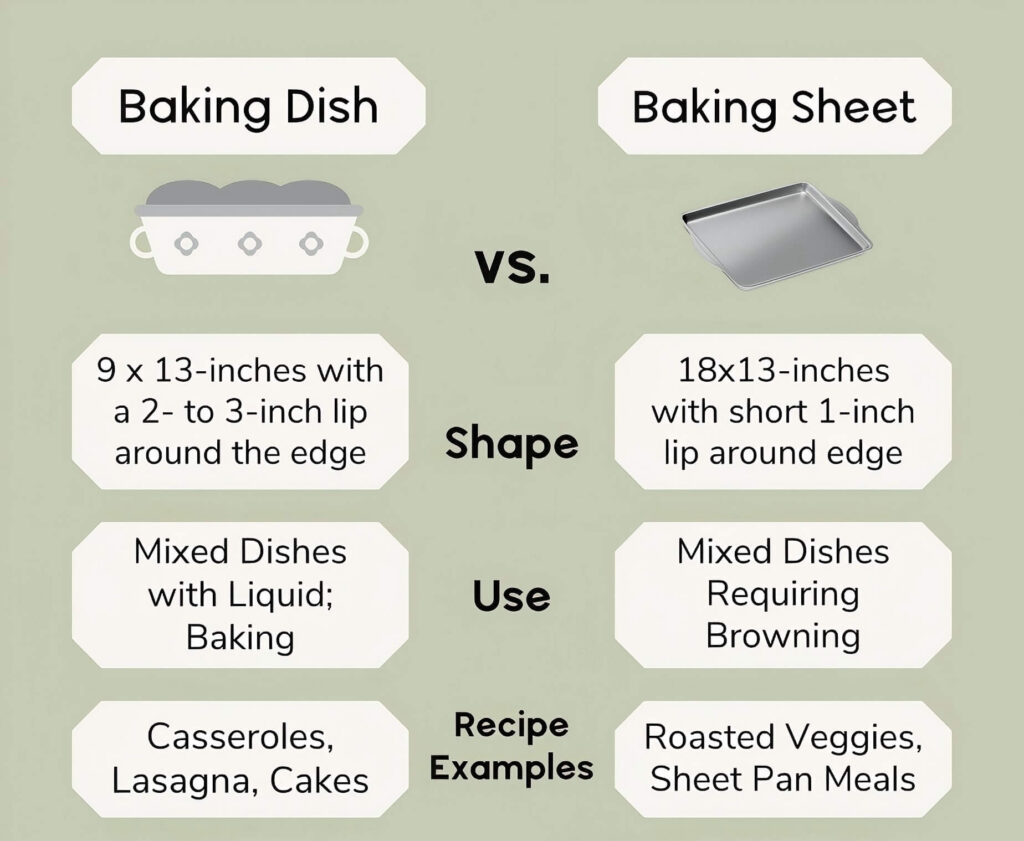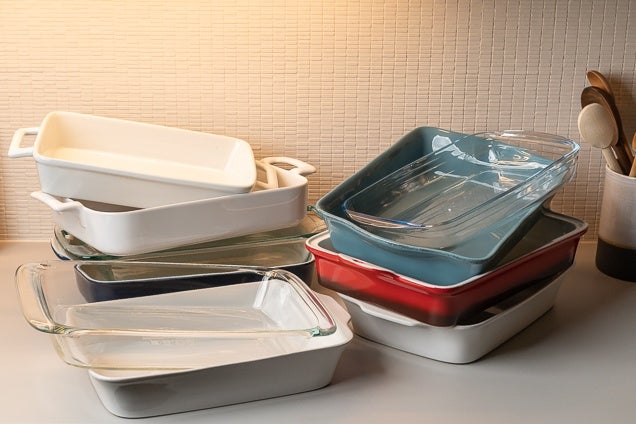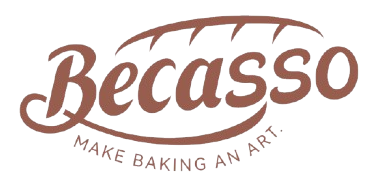Pendahuluan
Dalam dunia memanggang, alat yang Anda gunakan dapat membuat atau menghancurkan kreasi kuliner Anda. Dari kue kering hingga casserole, jenis peralatan memanggang yang Anda pilih secara langsung memengaruhi tekstur, rasa, dan presentasi hidangan Anda. Namun, banyak pembuat roti rumahan yang mengabaikan pentingnya memilih peralatan yang tepat, terutama dalam hal loyang vs loyang. Memahami perbedaan antara kedua alat penting ini tidak hanya meningkatkan keterampilan memanggang Anda, tetapi juga memastikan resep Anda menjadi sempurna setiap saat.

Apa yang dimaksud dengan Loyang?
A. Definisi dan Karakteristik
Loyang adalah bahan pokok dapur serbaguna, biasanya terbuat dari bahan seperti kaca, keramik, atau periuk. Bahan-bahan ini dikenal dengan retensi panas yang sangat baik dan distribusi yang merata, yang sangat penting untuk resep yang membutuhkan memasak secara perlahan dan konsisten. Loyang sering kali memiliki sisi yang lebih tinggi, membuatnya sempurna untuk resep yang banyak cairan seperti lasagna, casserole, dan makanan penutup yang dipanggang.
B. Jenis-jenis Piring Pemanggang yang Umum
- Piring Pemanggang Kaca: Ini memungkinkan Anda untuk melihat makanan saat dimasak, membantu Anda memantau kecoklatan dan gelembung. Alat ini ideal untuk hidangan seperti kroket dan gratin.
- Piring Pemanggang Keramik: Dikenal karena daya tarik estetika mereka, piring keramik sangat cocok untuk disajikan langsung dari oven ke meja. Piring ini dapat menahan panas dengan baik, menjaga makanan tetap hangat lebih lama.
- Piring Pemanggang dari Periuk Tanah Liat: Tahan lama dan sederhana, periuk sangat baik untuk distribusi panas yang merata dan sering digunakan untuk makanan rumahan yang lezat.

Apa yang dimaksud dengan Loyang?
A. Definisi dan Karakteristik
Loyang biasanya dibuat dari logam, seperti aluminium atau baja tahan karat. Bahan-bahan ini menghantarkan panas dengan cepat dan efisien, sehingga ideal untuk resep yang membutuhkan pemanggangan cepat dengan suhu tinggi. Loyang biasanya memiliki sisi yang lebih rendah dan dirancang untuk metode memasak dengan panas kering, seperti memanggang dan memanggang kue atau kue kering.
B. Jenis-jenis Loyang yang Umum
- Panci Lembaran: Datar dengan pinggiran berbingkai, loyang lembaran adalah pilihan tepat untuk memanggang kue, memanggang sayuran, dan bahkan membuat kue lembaran.
- Panci Roti: Ini sempurna untuk roti, kue pon, dan bahkan meatloaf, memberikan bentuk dan struktur yang ideal.
- Panci Muffin: Didesain dengan banyak lubang, loyang muffin sangat penting untuk memanggang muffin, cupcake, dan bahkan quiches mini.
Perbedaan Utama Antara Loyang dan Panci
A. Bahan
- Piring Kue: Terbuat dari bahan penahan panas seperti kaca, keramik, atau periuk.
- Loyang: Dibuat dari logam yang menghantarkan panas, seperti aluminium atau baja tahan karat.
B. Bentuk dan Ukuran
- Piring Kue: Biasanya memiliki sisi yang lebih tinggi dan hadir dalam berbagai bentuk, termasuk persegi panjang, persegi, dan bulat.
- Loyang: Pada umumnya menampilkan sisi yang lebih rendah dan rata, serta tersedia dalam berbagai ukuran, dan sering kali didesain untuk resep tertentu.
C. Tujuan Penggunaan
- Piring Kue: Ideal untuk resep yang memerlukan pemasakan yang lambat dan merata, seperti casserole, lasagna, dan makanan penutup yang dipanggang.
- Loyang: Paling baik untuk metode memasak dengan panas kering, seperti memanggang dan membuat kue kering, kue, dan roti.
Memilih Alat yang Tepat untuk Pekerjaan
A. Faktor yang Perlu Dipertimbangkan Saat Memutuskan Antara Loyang dan Loyang
- Persyaratan Resep: Analisis kadar air dan waktu memasak. Sebagai contoh, casserole mendapat manfaat dari panas yang merata dari loyang, sementara kue kering tumbuh subur dengan panas yang cepat dan langsung dari loyang.
- Hasil yang diinginkan: Pertimbangkan tekstur dan penampilan yang ingin Anda capai. Kerak yang renyah mungkin memerlukan panci logam, sementara bagian dalam yang lembap dan lembut membutuhkan piring keramik.
- Properti Material: Pahami sifat konduksi dan retensi panas dari bahan. Kaca dan keramik menahan panas lebih lama, sedangkan panci logam cepat panas dan dingin.
Kiat Sukses Memanggang Kue
A. Perawatan dan Pemeliharaan Loyang dan Panci Pemanggang yang Tepat
- Pembersihan: Gunakan pembersih yang lembut dan tidak abrasif untuk menjaga keutuhan peralatan roti Anda. Hindari menggosok dengan keras yang dapat merusak permukaan.
- Penyimpanan: Simpan loyang dan wajan dengan benar agar tidak pecah, melengkung, atau tergores. Melapisi wajan dengan lapisan pelindung dapat memperpanjang masa pakainya.
- Pemanasan awal: Panaskan piring kaca atau keramik secara bertahap untuk mencegah guncangan panas, yang dapat menyebabkan keretakan.
B. Kesalahan Umum yang Harus Dihindari Saat Menggunakan Loyang dan Panci
- Bahan yang salah: Menggunakan bahan yang salah dapat menyebabkan masakan tidak merata atau hasil yang tidak memuaskan. Selalu pilih alat yang sesuai berdasarkan resep.
- Kepadatan: Kepadatan yang berlebihan dapat menyebabkan pemanggangan yang tidak merata, khususnya di dalam loyang. Pastikan jarak yang tepat untuk memungkinkan sirkulasi panas yang merata.
- Kesalahan Manajemen Suhu: Tidak menyesuaikan suhu berdasarkan bahan makanan dapat menghasilkan hidangan yang kurang matang atau terlalu matang. Ikuti panduan resep dengan cermat.
Tanya Jawab tentang Loyang vs Loyang
1. Apa Bahan Terbaik untuk Loyang?
Bahan terbaik tergantung pada resepnya. Kaca dan keramik sangat baik untuk memasak dan penyajian yang merata, sedangkan periuk menawarkan daya tahan dan retensi panas. Setiap bahan memiliki manfaat unik yang cocok untuk berbagai jenis hidangan.
2. Dapatkah Saya Menggunakan Loyang Sebagai Pengganti Loyang?
Meskipun Anda dapat mengganti salah satu panci dengan panci lainnya dalam kasus tertentu, namun sangat penting untuk menyesuaikan waktu dan suhu memasak. Piring pemanggang mungkin memerlukan waktu memasak yang lebih lama dan suhu yang lebih rendah dibandingkan dengan panci logam.
3. Bagaimana Cara Mencegah Makanan Menempel di Loyang atau Wajan?
- Pelumas: Oleskan tipis-tipis mentega, minyak, atau semprotan masak untuk mencegah lengket.
- Kertas Perkamen: Lapisi loyang Anda dengan kertas roti agar makanan yang dipanggang mudah dikeluarkan.
- Pemanasan Awal yang Tepat: Pastikan piring atau wajan Anda dipanaskan terlebih dahulu secara memadai untuk meminimalkan lengket dan mendorong pemasakan yang merata.
Kesimpulan
Loyang dan wajan adalah alat yang sangat diperlukan di dapur mana pun, masing-masing dengan karakteristik dan kegunaannya yang unik. Memahami perbedaannya dan memilih yang tepat untuk resep Anda dapat meningkatkan hasil pemanggangan Anda, memastikan hidangan yang lezat dan disajikan dengan indah. Baik Anda memanggang casserole yang lezat atau sekumpulan kue kering, memilih alat yang tepat adalah kunci keberhasilan. Dengan mempertimbangkan bahan, bentuk, dan tujuan penggunaan, Anda dapat membuat keputusan yang tepat untuk meningkatkan pengalaman memanggang Anda. Selamat memanggang!

